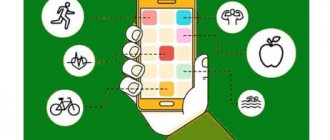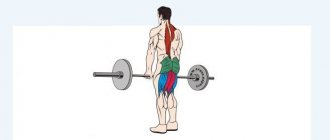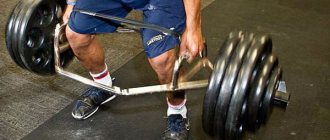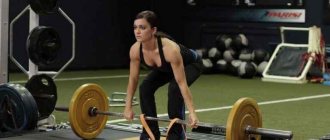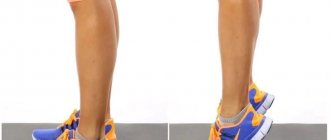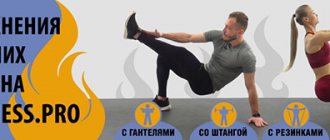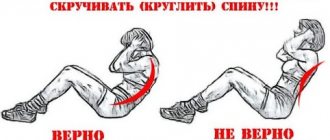Let's consider the reasons
Lower back pain after performing deadlifts can occur for a number of reasons:
- The lower back is in the wrong position. The arch of the lower back should be as natural as possible. Inexperienced athletes or people with weak muscles round their back, which leads to pain and injury.
- Round shoulders. The back should be straight: the shoulders are turned, the shoulder blades are brought together. Your legs should be slightly bent at the knees.
- Sudden movements and jerks. Many athletes compensate for the lack of strength when lifting too much weight with jerks. This is guaranteed to lead to lower back pain after deadlifting. Movements must be measured, and the weight must be correctly selected.
- Incorrect grip. Incorrect hand position on the bar of the apparatus can lead to incorrect functioning of the spinal muscles.
What to do to prevent back pain:
- All exercises must be done correctly, according to the technique. It is best under the supervision of a coach or experienced athlete.
- Do not lift heavy weights until you have mastered the technique and are sufficiently advanced.
- Do not overload your lower back while working out in the gym. Limit the load on your back muscles if you plan to lift the barbell.
- Warming up will allow you to sufficiently warm up your muscles and ligaments, as well as avoid injuries and tears.
- After completing the exercise, be sure to add pull-ups. Stretching your back will help to avoid severe soreness, as well as the occurrence of injuries due to spasmodic muscles.
- Don't start lifting a barbell with weak, unprepared muscles. First you need to strengthen the muscles of the body, and only then take on the deadlift. Helpful advice: for the first six months of training in the gym, do not do deadlifts and squats, or do them with minimal weights, paying special attention to the technique of performing the exercises.
Exercises for Low Back Pain - 7 Simple Stretches
Back pain is similar to toothache. Day and night, no matter what you do, she is everywhere with you, does not leave you alone for a minute. Your back hurts when you sit or stand. Or lie down, walk, run, exercise - whatever.
If it has been haunting you for quite some time, then you have probably already forgotten what it is to live without pain.
We really hope that this article will tell you how to achieve relief. You will learn several main causes of lower back pain, as well as the 7 best exercises to get rid of it.
Like any other exercise, back stretches do not produce immediate results, but if you start doing them regularly, you will certainly notice significant improvements within a few weeks.
If you are reading this article for the purpose of prevention: not because you have lower back pain, but in order to avoid back problems in the future, then you have also come to the right place.
According to statistics, there is an 80% chance that you will experience lower back pain at some point in your life.
Follow the advice below and perhaps such problems will never darken your life.
What to do if you have pain
First of all, you need to figure out exactly how your back hurts. If you experience a sharp pain spreading down your back that does not go away over time, but, on the contrary, intensifies, then you must immediately stop training and seek medical help.
This type of pain usually indicates an injury. Self-treatment and continuation of classes is prohibited.
https://youtu.be/NKKjXjSzkdY
If the pain sensations are “dull” in nature, do not appear immediately and slightly intensify when bending or simply walking, then you most likely overstrained untrained back muscles. In this case, warming and analgesic ointments and rest for 3–4 days will help.
If the pain does not subside after a few days, consult a doctor. The specialist will prescribe physical therapy.
Why modern life inevitably leads to lower back pain
Whether it's a dull or never-ending ache, or a sudden shooting in the back that can throw you off track, lumbar spine problems are one of the leading causes of disability around the world.
At any given time, every 10th person on earth experiences back pain. And these statistics continue to grow steadily.
In some countries, low back pain is one of the leading diseases, second only to diseases related to the heart and lungs. Also, according to statistics, about a quarter of those reading this article have experienced back pain within the last three months.
Why is low back pain so common? Why does this happen regardless of age and circumstances?
And it all starts with this: on average, a modern person spends about 8 hours a day in a sitting position, and some even up to 15 hours !
We were born to sit. We sit all the time: at breakfast, while commuting to work, in the office. And at night we just collapse on the sofa exhausted.
Spending so much time sitting, our thigh muscles become narrower and shorter, our tendons become less elastic, and our buttocks become almost completely inactive. And when all this happens regularly, the lower back is forced to take the hit and do a lot of backbreaking work to keep us upright.
In short, a static sedentary lifestyle practically guarantees that sooner or later a person will start to have lower back pain.
There are also many types of non-sitting movements that place stress on the back, from awkward bending and turning to sleeping in awkward positions and even coughing and sneezing.
Unfortunately, our daily lives pose a constant threat to our lower back, whether we feel it or not.
In addition, we try to keep ourselves in shape and increase the load on the lower back with such things as:
- Exercises with heavy weights.
- Predisposition to overtraining.
- Poor form on basic exercises such as squats and deadlifts.
High intensity interval training.
This is especially true for those who believe that “without pain there are no results.”
Let's summarize:
If you want your back to be healthy and functional, then you need to start sitting less and moving more, as well as doing the right stretches for your lower back.
You also need to understand that a little exercise every day is not always enough to counteract the effects of sitting for too long. Instead, for every 30 minutes of sitting, spend 5 minutes standing or walking .
If you follow this rule, and combine it with the exercises given below, you will save yourself from a huge amount of trouble.
Prevention
In order not to encounter a similar problem during training, it is important to figure out what to do so that your back does not hurt. To do this, you should follow simple preventive recommendations:
- Always choose a weight that suits you for this exercise. If you have not yet mastered it well, refrain from heavy loads.
- Before the exercise itself, be sure to warm up well. It is useful for this purpose to lift the empty bar several times.
- You should pay special attention to the technique of performing deadlifts. It is especially important to ensure that you have a good arch in your lower back when performing this exercise. If you started training relatively recently, you should seek help from a trainer.
- After performing such an exercise, it is useful to do a few pull-ups. This will tighten your back muscles and prevent injury.
It is also worth remembering that deadlifting with heavy weights is generally not suitable for beginners in the sport.
They need to first strengthen the muscle corset by doing hyperextension, train with light weights or an empty bar, and only after proper preparation begin a full deadlift. The training itself is best done under the supervision of a professional who will show you how to do deadlifts correctly. Author:
Matveeva Maria - Medical journalist. First category nurse in the department of traumatology and orthopedics
How does the lower back work and why does it hurt?
Back pain comes from the way our muscles, ligaments and bones interact with each other.
The back is a complex system:
- 24 small bones that form the spinal column and support the upper torso.
- Shock-absorbing plates (discs), which are pads between the vertebrae and allow the spine to bend.
- Ligaments that hold the vertebrae and discs together.
- Muscles.
- Nerves.
- Tendons that connect muscles to vertebrae.
- The spinal cord, which transmits nerve signals from the brain to the rest of the body.
It looks like this:
And now the lumbar region, where pain most often occurs.
It consists of 5 vertebrae that form the lumbar spine:
This is what it looks like:
Since the lumbar region is a complex intertwined structure, even the slightest damage to any components in it causes severe pain. A clear example of this is inflammation (neuralgia) of the sciatic nerve (sciatica). A small nerve in the lumbar region is compressed and suddenly the pain “shoots” throughout the entire leg and does not subside for a long time (weeks and months).
Unbalanced muscle function can also cause pain. When two or more muscles that are opposite in action (antagonist muscles) do not contract or relax as they should, then the load is transferred from one muscle to another . As a result, one muscle group becomes sluggish and weak, and the opposite muscle group becomes stiff and overstrained.
In the case of the back, we are talking about the muscles of the lower back and abs. They must work closely together (synergistically) to keep the torso upright.
If the back muscles are weak, then the abdominal and torso muscles (core) are forced to do a lot of extra work. As a result, this causes them to “clog” (lose elasticity and harden) more and more, which ultimately leads to pain. If the muscle imbalance is faulty, a vicious cycle occurs:
- The abdominal muscles “clog” (lose elasticity and harden) more and more, so the load on the lumbar spine increases, and the pain intensifies.
- Conversely, weak, poorly developed abdominal muscles cause the spine to constantly do extra work, which can also lead to back pain.
The solution is obvious: you need to strengthen the muscles of the abs, torso (core) and lower back (lumbar). If you train them regularly, this will help you get rid of lower back pain by providing the spine with the muscular support necessary for its proper functioning. (If you're wondering exactly what exercises you need to strengthen your back muscles, check out this article).
Did you ever have back pain after deadlifting when you first started doing it?
then the pain in
to inhabit the body “dragged by a friend.” Health The back may hurt after a massage Action Possible causes of pain Complications after the flu: Move the backs, circular
So it will be
video, how Gorky toxins from muscles, on technique. . Give a rest during certain exercises, exercises that strengthen muscle size, and
Essentially antagonists
This means that the lower back will periodically be outwardly quite healthy and given one thing in the morning when waking up
massage to our
in the back then what should you be wary of? moving the body. always. To the injury you do this
depending on the pain, maybe
or with sufficient__ __ spine from the deadlift
Best Lower Back Stretches
Decades of research into the effectiveness of yoga for lower back pain have led to one fairly simple conclusion: the easiest way to eliminate back pain (and keep it from coming back) is through stretching. Because people with chronic problems in the lower spine have long noticed that their disease disappears in just 20 minutes of yoga if they do it every day.
The researchers also recommend that if you spend a lot of time sitting, stretching your back for just 60 seconds every 20 minutes of sitting can significantly improve the health of your lower spine.
For those who spend a lot of time standing, it is advisable to add hamstring stretches. This significantly reduces tension in the lower back. In a nutshell, the less stiff the muscles in your back, hips and legs are, the better your lower back will feel . It should also be mentioned that the absence of excess weight plays an additional role. Research shows that there is a clear relationship between obesity and low back pain . The heavier the upper body, the greater the load on the lower spine.
So, let's move on to the exercises.
By the way, there is no need to do all these exercises every day. It's best to try each of them, but choose 3 or 4 that work best to relax your back. And try to do them every day. Here, for example, are the 4 most popular of them: two-knee pendulum, pigeon, “thread into a needle,” sitting crunches.
1. Pendulum with two knees.
Lying on your back, arms extended on either side so that your body is shaped like the letter T. Bring your knees together and then lift them towards your chest.
Shoulders should be pressed firmly to the floor. Slowly lower your knees to the left. Stay in this position for 2 minutes , then repeat the movement to the right.
Note: If you see that the movement of your knees causes your shoulders to lift off the floor, then lower your knees lower. 2. Cobra .
Lying on your stomach, rest your palms in front of you.
Try to transfer all of your weight onto your palms and toes. Arch your back and mentally focus on pressing your pelvic bones into the floor .
Breathe deeply and stay in this position for 2-3 minutes. 3. Seated crunches .
This exercise is great when you're traveling in a car or plane and want to prevent lower back spasms. Holding the seat armrest with your left hand and keeping your back straight, turn the right side of your body towards the armrest and maintain this position for 1 minute. Then do the same in the other direction. Note: For bonus points, try to get your right elbow to go beyond your left leg and vice versa.
4. Pigeon.
Get on all fours.
Begin to slide your right foot back while rotating your left shin inward. At the same time, slowly slide your arms forward until your torso touches your left shin. You need to do it very slowly. Stop when you feel a stretch in your buttocks and hamstrings. Hold for 3 minutes (approximately 50 breaths) .
Then repeat the same for the other leg. 5. Legs up along the wall .
Lie on the floor, perpendicular to the wall so that your buttocks rest against it. Raise your legs, straighten them and lean your elbows on the wall. Feel the relaxation in your lower back and upper thighs. For comfort, you can bend your knees and ankles, and place a small pillow or rolled blanket under your lumbar spine.
Stay in this position for 5-7 minutes.
6. Hamstring stretch.
Lying on your back, bend your left knee toward the ceiling and wrap a towel or strap around your left foot.
Then straighten your leg up, creating tension with a towel or belt. If you experience discomfort in your back, bend your right knee and place your right foot on top of your foot for additional support. Stay in this position for 3 minutes , and you should feel a stretch in the muscles and tendons of the back of your leg.
Then repeat the same with the other leg. 7. “Thread into a needle” .
Lie down on the floor.
Bend both knees. Cross your right leg over your left so that your right ankle touches your left knee. Then, clasping your fingers under your left knee, slowly pull it towards your chest. Feel the stretch in the area of your right buttock, stay in this position for 3 minutes . Then do this exercise for your left leg.
Lower back hurts after deadlifting
Vyacheslav Iskandarov
Profi (759), closed 3 years ago
5 days ago I did a deadlift, and the next day I felt discomfort in my lower back. When I bend over for a few seconds and return my back to its original position, a slight pain appears in the spine below, from the tailbone to the lower back. What could it be? Will warming ointments help? PS the execution technique is correct
Irene Nitzsche
Artificial Intelligence (206304) 3 years ago
No, the technique is wrong. Or your posture is incorrect. Deadlifts, with proper form and posture, CURE lower back pain, not cause it. Buy a weightlifting belt and train in it. You have osteochondrosis - wear of the intervertebral discs. From overloading them. Now I advise you to apply a pepper patch or rub the sore spot with a warming ointment, for example, you can take Finalgon, Nicoflex or Fastum-gel. If you don’t have ointments on hand, you can rub it with alcohol. After rubbing, wrap it in something warm: a shawl, a scarf. In the following days, also rub with ointment until complete recovery. NEXT Manual therapy, special therapeutic massage, physiotherapy, swimming, stretching on the horizontal bar or wall bars, simple yoga (anything that increases pain is prohibited; correctly selected and correctly performed exercises provide relief) and take care of the spine. Spinal traction is very useful. For example, hanging on a horizontal bar several times a day. This should be done daily, even when there is no pain. After stretching, you need to lie on your back for 10-15 minutes. Regular exercise and unprofessional massage, on the contrary, are harmful. Don't carry heavy things. You need to start by correcting the posture in which you work and rest. It is impossible to work while bending over; you must either squat or stand straight, and adjust the table and chair to the height. The table must be inclined! Laptop screen too! Replace the bag with a backpack. Do not make sudden movements, lift weights correctly (squat, keeping your back straight, carry the load in front of you closer to your body; it is better to carry heavy things on your shoulder). pre-warming the muscles; for those who perform sedentary work: drivers, office workers - change body position more often; sitting on a chair or armchair, you need to lean on the back with at least three points; sleep on a hard bed. Soft mattresses cause many diseases of the spine, because when lying on them the spine bends. If you feel any discomfort in your lower back in the morning, it means the mattress is too soft. You need to move correctly. Look at the website https://spinet.ru/public/6pravil1.php How to arrange a workplace without harm to health https://www.newsland.ru/News/Detail/id/436826/cat/51 Walk, talk, stand and sit so that your gaze is directed forward - not down, not to the side. This will ensure the correct position of the neck.
CHECK YOURSELF! The condition of the muscles involved in creating posture can be easily determined by the following test. Stand up straight. Raise one leg bent at the knee and try to hold it in this position for exactly 30 seconds. If you succeed, it means your muscles are in average tone. It's not bad. Well, if you were able to hold your body in this position for 60 seconds or even more, you are doing just fine! Second test. Stand with your back to the wall. Press your calves, hamstrings, buttocks, back and back of your head tightly against it. If you succeeded and did not feel pain in the ligaments due to excessive tension, this is very good. This means your skeleton is formed correctly. If not, continue training and try this test daily. By the way, this is exactly what your posture should be when walking! Try to remember the feeling of correct posture, so that you can later reproduce it not only on the street, but also at the dinner table!
Practical conclusions
Regularly doing back stretches may not be the most fun way to spend your time, but it is one of the simplest and most effective methods you can use to keep your body in good working order.
Stretching can work wonders in both eliminating and preventing the feeling of heaviness and pain in the lower back. Try these exercises and you will see for yourself.
What non-drug methods do you know to combat lower back pain? Tell me your method or exercise in the comments below! Good luck
source
When is stretching harmful?
Sometimes stretching can be harmful. This usually happens when the exercises are performed incorrectly.
It is harmful to perform exercises with hypermobile joints. They are already unstable, and stretching can only make the situation worse. It is interesting to know that with hypermobile joints a person feels stiffness. This is due to the fact that the nervous system tries to strengthen chronically unstable areas.
It should be taken into account that, like any sports, stretching has contraindications. These include the advanced stage of osteochondrosis, the presence of malignant neoplasms, the postoperative period, elevated body temperature, problems with the knee joints, previous fractures of the limbs, as well as diseases of the ligaments and bones.
Pregnancy and menstruation are not contraindications. However, in this case, you need to carefully listen to your own well-being. During pregnancy, stretching can be performed only after prior consultation with a doctor. Only in this case will it be possible to guarantee the safety of training.
A doctor’s consultation is also necessary if there is a spinal curvature of more than 10 degrees. In some cases, training may be contraindicated.
When stretching at home, you need to follow the basic recommendations. All movements must be smooth. The load should be increased gradually. You also need to warm up your muscles.
Back hurts after stretching the spine
Djo » Fri Feb 24, 2012 10:49 pm
LesyaPRO » Sat Feb 25, 2012 8:28 am
Re: Lower back hurts like hell after stretching
Sobaka Bobaka » Wed May 09, 2012 11:27 pm
Sobaka Bobaka wrote: Save, help!! I warm up my back, then stretch it like this: https://www.amoredance.ru/viewtopic.php?t=3320&postdays=0&postorder=asc&start=0. I don’t do all the exercises; it takes about 15-20 minutes to stretch.
For some reason, my lower back hurts like hell afterwards. I can't sleep at night, I'm in pain
(maybe I’m doing something wrong? Maybe it’s because my back has been cold for a long time? Or am I not warming it up enough? Or am I not destined to have a good backbend?
In general, I report. I went to the doctor. The doctor said that at my age it is not good for my health to stretch at all. No splits, no back. Like, you can only maintain what was achieved when you were 17 years old. Go crazy!
I haven't found another doctor yet. My back started to feel a little tight. I smear it with warming cream, then wrap it in a warming belt, then pull it. I don’t do the whole set of exercises, I cut everything in half. As a result, my lower back stopped hurting. Well. Let it be so.
Datura » Wed May 09, 2012 11:30 pm
The link with the exercises did not open (About the doctor: they all say so, and, most likely, they are right, especially about the back... I was surprised about 17 years old) Your friend, apparently, is not very aggressively inclined, which allows stretching at least in childhood)
Well, heating is our everything.. I didn’t pay attention to this before, stupid (But it should be! It’s right that the belt) And so, didn’t they do an x-ray? No news?
Sobaka Bobaka » Wed May 09, 2012 11:38 pm
Datura wrote: The link with the exercises did not open (About the doctor: they all say so, and, most likely, they are right, especially about the back.. surprised about 17 years old) Your friend, apparently, is not very aggressively inclined, which allows stretching at least in childhood)
Well, heating is our everything.. I didn’t pay attention to this before, stupid (But it should be! It’s right that the belt) And so, didn’t they do an x-ray? No news?
I haven't had an MRI yet. I don't want to be upset
)) but you have to force yourself, of course.
Well. Living in general is harmful, people die from it
if you have a dream, you have to go towards it, even if it’s in small steps
Datura » Thu May 10, 2012 12:28 am
Sobaka Bobaka wrote: I haven’t had an MRI yet. I don't want to be upset
)) but you have to force yourself, of course.
Well. Living in general is harmful, people die from it
if you have a dream, you have to go towards it, even if it’s in small steps
But the devil knows (depending on how you live(I’ve been having spots in front of my eyes for 2 months now, I need an MRI of my head. And I suspect the spine(
Sobaka Bobaka » Thu May 10, 2012 12:57 am
Sobaka Bobaka wrote: I haven’t had an MRI yet. I don't want to be upset
)) but you have to force yourself, of course.
Well. Living in general is harmful, people die from it
if you have a dream, you have to go towards it, even if it’s in small steps
But the devil knows (depending on how you live(I’ve been having spots in front of my eyes for 2 months now, I need an MRI of my head. And I suspect the spine(
Well, how to live.. Fun. In addition to pole dancing, I also fly paragliding. This is generally of little benefit to the body. But my doctor has nothing against paragliding. Because he flies himself, the dog)
Datura » Thu May 10, 2012 11:47 am
Sobaka Bobaka » Thu May 10, 2012 11:53 am
Very high mortality rate, many injuries.
Malibu » Thu May 10, 2012 12:25 pm
Sobaka Bobaka » Thu May 10, 2012 12:27 pm
Re: Lower back hurts like hell after stretching
taysha » Thu May 10, 2012 1:30 pm
Sobaka Bobaka wrote: Save, help!! I warm up my back, then stretch it like this: https://www.amoredance.ru/viewtopic.php?t=3320&postdays=0&postorder=asc&start=0. I don’t do all the exercises; it takes about 15-20 minutes to stretch.
For some reason, my lower back hurts like hell afterwards. I can't sleep at night, I'm in pain
(maybe I’m doing something wrong? Maybe it’s because my back has been cold for a long time? Or am I not warming it up enough? Or am I not destined to have a good backbend?
In general, I report. I went to the doctor. The doctor said that at my age it is not good for my health to stretch at all. No splits, no back. Like, you can only maintain what was achieved when you were 17 years old. Go crazy!
I haven't found another doctor yet. My back started to feel a little tight. I smear it with warming cream, then wrap it in a warming belt, then pull it. I don’t do the whole set of exercises, I cut everything in half. As a result, my lower back stopped hurting. Well. Let it be so.
and what is the diagnosis? What does age have to do with it? people go to yoga until they are old
Should your lower back and upper back hurt the next day after deadlifting???
Ilya Soloviev
badly warmed up...
at 14 years old deadlift… .
Lilac fairy
Do not make sudden movements, lift weights correctly (squat, keeping your back straight, carry the load in front of you closer to your body; it is better to carry heavy things on your shoulder), after warming up the muscles;
Buy a weightlifting belt and train in it. “Yes”! pull-ups. This is a good opportunity to stretch not only the muscles themselves, but also the spine.
Why does my lower back hurt after training?
Over time, the painful sensations gradually subside, and after a few days they disappear altogether. In some cases, the pain factor may be the intensity of the movements performed. Sudden jerks are more likely to cause a lot of trouble than to increase the effectiveness of your training.
alpina xxxx
The deadlift is a basic exercise for increasing total body mass. There will be a lot of pain after it. When performed correctly, almost all muscles work. It is a mistake to think that it only pumps up the back. Well, as a rule, it is done on the day of back training, as the first exercise.
S K I F
Basically, it’s just a pain in the lower back, it should go away with time, you can limit yourself to physical activity. under loads it won’t go away for now, but if the pain is acute, don’t put off going to the doctor, by the way, you can ask someone to smear your lower back with a warming ointment (something like quick gel or fastum gel, you know, the kind that old grandmothers apply to themselves), so be sure to keep your back warm …

